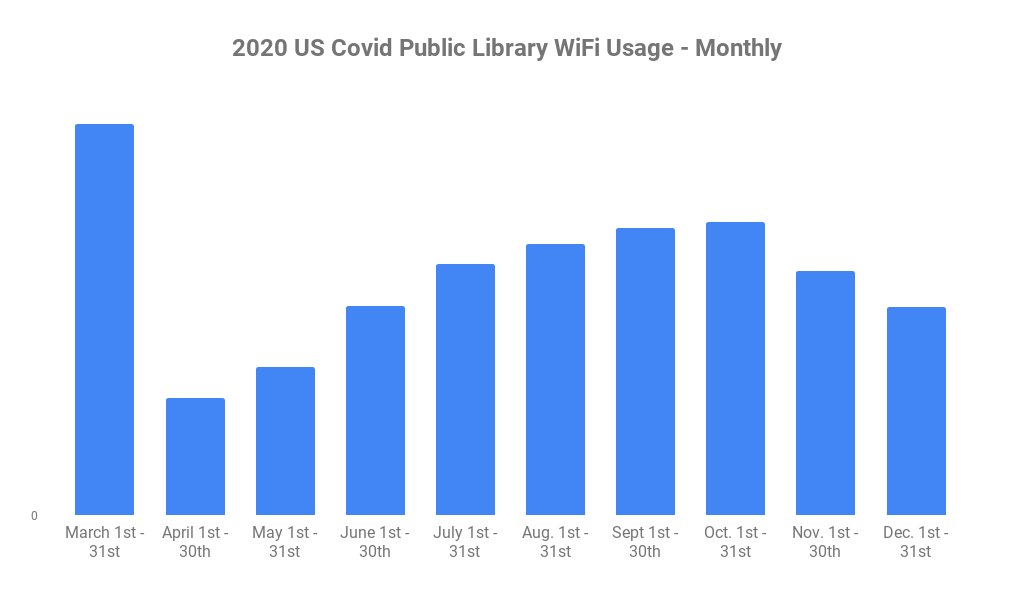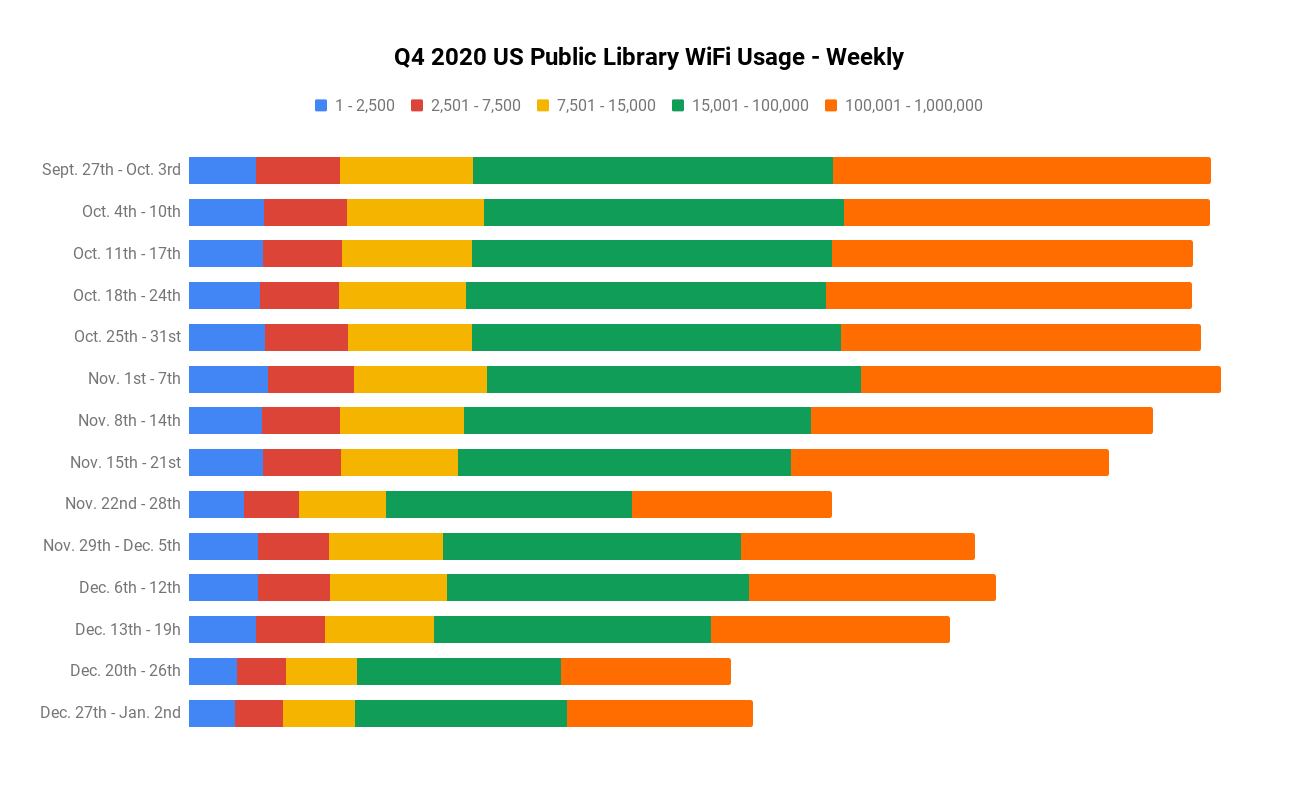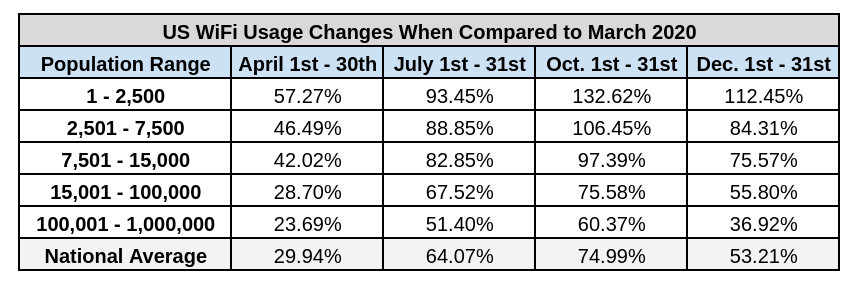Q4 Effects of COVID-19 on Public Library WiFi Use
WhoFi analyzed data from our library partners to determine the effect of COVID-19 on patron WiFi usage. This report includes our findings during Q4 2020.
We’re now ten months into the COVID pandemic, and public libraries continue to adapt to this new normal by reinventing their services to meet the current needs of their communities. These new innovations are taking place across the country. Libraries are bolstering their online collections and expanding access, enhancing access to public WiFi, making it easier to get a library card, starting and adding to their virtual programming, adding outdoor programming, offering curbside pick-up, and curated book bags, to name a few.
This new reality created an environment for public libraries to rethink and improve how they serve communities. In many cases, libraries have migrated their in-person programming to the digital space. The flexibility of online programming is helping libraries reach additional community members. For some programs, this has resulted in increased attendance since patrons can attend storytime or participate in a seminar at their convenience and without concern for building capacity.
Many library buildings have reopened, but are operating at a limited capacity in accordance with safety guidelines. Services like grab-and-go, limited computer use, and printing/scanning/faxing are available inside the building, while other programming and outreach remain online. Libraries are providing more online resources (e-books, e-magazines, database access), virtual programming (storytime, craft sessions, etc), and WiFi access. In our library partners’ opinions, these services will continue in the future even after COVID. New demands such as video conferencing and e-learning make having high-speed internet vital to meet the changing needs of both the library and the community it serves.
Through the fall and into the beginning of winter, how has COVID affected library WiFi use in Q4?
Our data shows that after the initial drop in WiFi usage in March, trends steadied and then began to rise around April 26th. There continued to be a steady increase in WiFi usage nationwide across cities and towns of all population sizes. Only most recently during the holiday season did we see the upward trend take a slight downturn. This slight decline is most visible during the weeks surrounding the Thanksgiving, Christmas, and New Year holidays. Library efforts to enhance and extend WiFi services, paired with a solid communication plan, seem to have the desired effect of helping their community members stay connected. The total number of visits, however, isn’t as high as it was prior to shut-downs, but shows continued use despite building closures. The graph below shows WiFi usage trends from March through December.
The Holidays and Seasonality still affect WiFi usage.
The chart below provides a week over week look at the WiFi usage throughout the quarter. This view really highlights what took place and the cause for the slight declines in November and December. The decrease in WiFi usage during the holiday weeks of Thanksgiving, Christmas, and New Years can be seen clearly below. Similar decreases can be found in previous years November and December WiFi utilization. This indicates that the decrease is more the result of seasonality.
Patrons in rural service areas often rely on the public library as their main source of internet.
Public libraries are already considered an anchor institution that provides the internet to the community. Throughout the pandemic we’ve seen a difference in the continued usage of public library WiFi when looking at the usage changes by population. Urban libraries had the largest decrease in usage when the pandemic hit and have had a slower return to normal.
Breakdown of WiFi usage rates by service population
The graph above shows the WiFi usage rates of each population grouping from March to December. The most dramatic change in usage can be found in the 100,000-1,000,000 category, which has only seen about a two thirds return to previous utilization. Another interesting statistic is the 1-2,500 and 2,500-7,500 population groupings, which by October had regained all of their previous WiFi usage rates prior to the beginning of the pandemic.
Libraries are important to communities, especially in times of crisis.
After speaking with our library partners, it’s clear these adapted library services are here to stay, even after COVID. The COVID crisis has opened doors for new ways of connecting communities and enhancing library services. High-speed internet will be necessary to continue to create and distribute online programming and meet community needs for WiFi used for work, school, and personal purposes.
What’s been created out of this crisis can’t replace how libraries operated previously, nor should it. Retaining offerings of a shared community space is valuable, and in-person gatherings is something people want even more now. When adapted services are done in combination with traditional methods, everyone wins.
Even before the coronavirus outbreak, lack of internet access was a big problem. Now, it’s critical. Public libraries are on the front lines of this problem helping patrons stay connected to school, work, and family. They’ve also been important for social services such as filing for unemployment and completing the census which requires a connection to the internet. The data is clear: WiFi is a valuable resource the libraries offer. Tracking this could prove to be beneficial for library advocacy efforts, operational improvements, strategic planning and accurate reporting for the PLS survey.
Contact us for more information or to book a demo.



